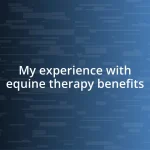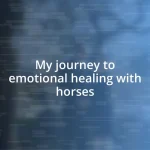Key takeaways:
- Equine-assisted therapy fosters emotional healing by facilitating a non-verbal connection between individuals and horses, allowing for profound self-discovery and resilience building.
- Key techniques like groundwork exercises and horsemanship improve communication, trust, and physical coordination, enhancing overall emotional and social skills.
- The long-term effects of therapy are significant, aiding in emotional regulation, grounding techniques, and cultivating a mindset that views challenges as opportunities for growth.

Introduction to equine-assisted therapy
Equine-assisted therapy is a unique form of therapy that involves interaction between individuals and horses, promoting healing and personal growth. I remember standing next to a gentle mare named Daisy during my first session, feeling an unexpected bond forming between us. How could such a large, powerful creature evoke such a sense of calm and understanding?
This therapy leverages the innate ability of horses to mirror human emotions, which often leads to profound self-discovery. I found myself reflecting on my feelings during exercises, realizing that the horse’s responses to my unease were spot on. Have you ever experienced a moment when another being seemed to understand you completely without a single word exchanged? That’s the magic of working with these incredible animals.
Through activities like grooming, riding, and ground work, participants can develop important emotional and social skills. I can vividly recall brushing Daisy’s coat, each stroke bringing a sense of connection and serenity. It made me wonder: what other emotional barriers could we break down if we allowed ourselves to engage so deeply with another living being?

Benefits of equine-assisted therapy
Engaging with horses in therapy has a remarkable impact on emotional well-being. I still remember a session where I was feeling particularly anxious. As I approached the horse, he nuzzled me gently, almost as if he could sense my turmoil. This simple gesture helped me ground myself, instilling a sense of peace that I hadn’t felt all day. It’s fascinating how these animals can tap into our emotional states, offering comfort without judgment.
The physical aspects of equine-assisted therapy are equally significant. For instance, balancing while riding a horse requires focus and coordination, which can help improve fine motor skills and enhance body awareness. I recall the exhilaration of finally mastering a trot—how empowering it felt to guide such a magnificent creature. This experience not only strengthened my physical abilities but also boosted my self-confidence in a meaningful way.
Moreover, the unique bond formed during these sessions fosters trust and communication skills. During one exercise, I had to lead a horse through a series of obstacles. It challenged me to communicate my intentions clearly, both verbally and non-verbally. I realized that, in life, fostering such connections is crucial for personal growth and relationship building. I left that day feeling more capable of navigating not just the course with the horse, but also my own interpersonal dynamics.
| Benefit | Description |
|---|---|
| Emotional Healing | Horses help individuals overcome anxiety and build emotional resilience through their intuitive nature. |
| Physical Development | Activities enhance coordination and motor skills, promoting physical health. |
| Social Skills | Working with horses boosts trust and communication skills, fostering better relationships. |

Personal journey into equine-assisted therapy
The first time I stepped onto the therapy grounds, I was filled with trepidation. However, as I caught sight of a chestnut-colored gelding named Max, my anxiety began to melt away. The way he approached me, curious and gentle, sparked a realization: it was not just about me; it was also about connecting with him. That essence of mutual trust transformed my perspective, making me eager to explore this new path.
- Max would mimic my emotions; when I relaxed, he would lower his head and nuzzle my shoulder.
- I discovered that focusing on his needs helped quiet my own worries, creating a beautiful synergy.
- The moments spent observing him were profound, as they taught me about patience and presence, both essential in life’s chaotic moments.
At one point, during a particularly tough session, I stood with my back against the fence, feeling overwhelmed. The mere presence of a horse, sensing my struggle, sauntered over and rested his muzzle against my leg. That gentle yet powerful gesture felt like a lifeline, demonstrating that with empathy and understanding, even the toughest obstacles can feel lighter. It’s hard to explain, but in those instances, I understood that healing often blossoms in silence, within a shared moment of connection.
- I learned to express my feelings openly—something I had struggled with before.
- Each session became a journey of self-reflection, allowing me to confront vulnerabilities I had long tucked away.
- The understanding I discover in the silence of equine interactions was unlike anything I had experienced before.

Key techniques used in sessions
In equine-assisted therapy, one technique that really stood out to me was the “groundwork exercise.” This involves working with the horse while still on the ground, building a connection without the added complexity of riding. I remember the first time I approached the horse, my heart racing. It was incredible how the horse seemed to mirror my feelings—when I was tense, he stepped back, and when I relaxed, he leaned in closer, teaching me so much about my own body language and emotions.
Another key technique is “horsemanship exercises,” which focus on establishing trust and communication. I found myself guiding the horse through an obstacle course that felt daunting at first. I began to ask myself: how do I convey what I want from him? This process made me aware of how much I had to articulate my thoughts, and slowly, I learned that clarity in communication led to better responses, not just with the horse, but also in my everyday interactions with people. I remember feeling a rush of triumph as we completed the course together, feeling that surge of accomplishment and bonding.
Finally, there’s a technique called “mounted sessions,” where you ride the horse to build a deeper emotional connection and physical coordination. The first time I mounted a horse, my fears and insecurities bubbled up; however, as the horse took its first steps, I felt a wave of exhilaration wash over me. I can’t help but wonder: what if this connection extends beyond just the therapy? It was empowering to experience the rhythm of our movements, it felt like a shared dance, where trust flowed both ways. Moments like these drove home the power of equine-assisted therapy, weaving together lessons in trust, emotional expression, and resilience.

Overcoming challenges in therapy
The journey through therapy isn’t always smooth sailing. I vividly recall a session where I felt particularly stuck, unable to articulate the jumble of emotions swirling inside me. In that moment, I just sat on a log, feeling defeated, until one of the horses wandered over, resting his head on my shoulder as if to say, “I’m here.” That simple act reminded me that even on the toughest days, overcoming challenges can come from unexpected places.
There were instances when fear threatened to override my progress. I remember a particularly daunting obstacle course that felt insurmountable. As I stood there, my heart racing, I asked myself: what was truly holding me back? It was then that I realized my inner doubts mirrored the horse’s body language. I learned to pause, breathe, and recognize that breaking down challenges into manageable steps made the path clearer. It wasn’t just about overcoming fear; it was about building resilience through each little success we achieved together.
I often wondered if I was truly making progress, especially during days when self-doubt crept in. However, there was something monumental about witnessing the transformation in both myself and the horse. With each session, I found that embracing vulnerability was key. It’s as though the more I allowed myself to be open, the lighter the load felt. Each small victory became a stepping stone, ultimately paving the way to greater self-acceptance and growth. Can you imagine the power of vulnerability in your own life? That realization alone reshaped my entire approach to challenges.

Long-term impacts of the therapy
The long-term impacts of equine-assisted therapy are profound and extend well beyond the therapy sessions themselves. I recall months after I completed my sessions, still feeling the lingering effects of that emotional connection with the horses. For instance, during a particularly stressful week, I found myself using grounding techniques learned in therapy, such as envisioning the calmness of a horse. This simple act helped anchor me in the moment, offering me a reminder of the serenity I experienced during my time at the ranch.
One significant transformation I noticed over time was increased emotional regulation. I once struggled intensely with anxiety, but I learned to recognize my triggers through my experiences with the horses. The way they responded to my emotions taught me to pause and reflect before reacting. I remember a day when I felt overwhelmed and took a moment to breathe, much like I would when working with a horse. That shift allowed me to approach situations with a new perspective, enhancing not just my work life, but my personal relationships as well.
Looking back, I’m often surprised at how deeply the therapy experienced shaped my long-term mindset. Each lesson learned felt like a seed planted within me, gradually blossoming into a newfound resilience. Can you relate to those moments when a breakthrough seems to occur during the quietest times? I now see every challenge as an opportunity for growth, driven by that initial bond forged with the horses. It’s a testament to how equine-assisted therapy can leave an indelible mark on our emotional landscape, nurturing lasting change in our lives long after the final sessions.

Resources for further exploration
Exploring resources around equine-assisted therapy can significantly enhance your understanding of its impacts. I often recommend checking out the Equine Assisted Growth and Learning Association (EAGALA), where you can find training opportunities, research, and certified professionals in the field. Their approach has always resonated with me, as it emphasizes the collaborative relationship between human and horse, fostering healing in a unique and profound way.
Another fantastic resource is the book “The Power of the Horse” by the celebrated psychotherapist, Leif Hallberg. I was captivated by his perspectives on how horses can facilitate emotional healing and personal growth. It made me reflect on my own therapy experiences and the subtle yet powerful lessons horses taught me about trust and vulnerability. Have you ever felt an unexplainable connection with an animal? Hallberg beautifully articulates that very bond and its potential for transformation.
For those interested in scientific studies, I suggest exploring journals like the “Journal of Equine Veterinary Science.” I recall delving into an article that discussed the measurable outcomes of equine-assisted therapy on anxiety and depression. Reading those findings helped validate my own experience, showing how the emotional exchanges I had with the horses were not just subjective feelings but grounded in research. It’s fascinating to see that the healing power of horses is being studied more rigorously. Isn’t it inspiring to uncover research that supports emotional healing?














